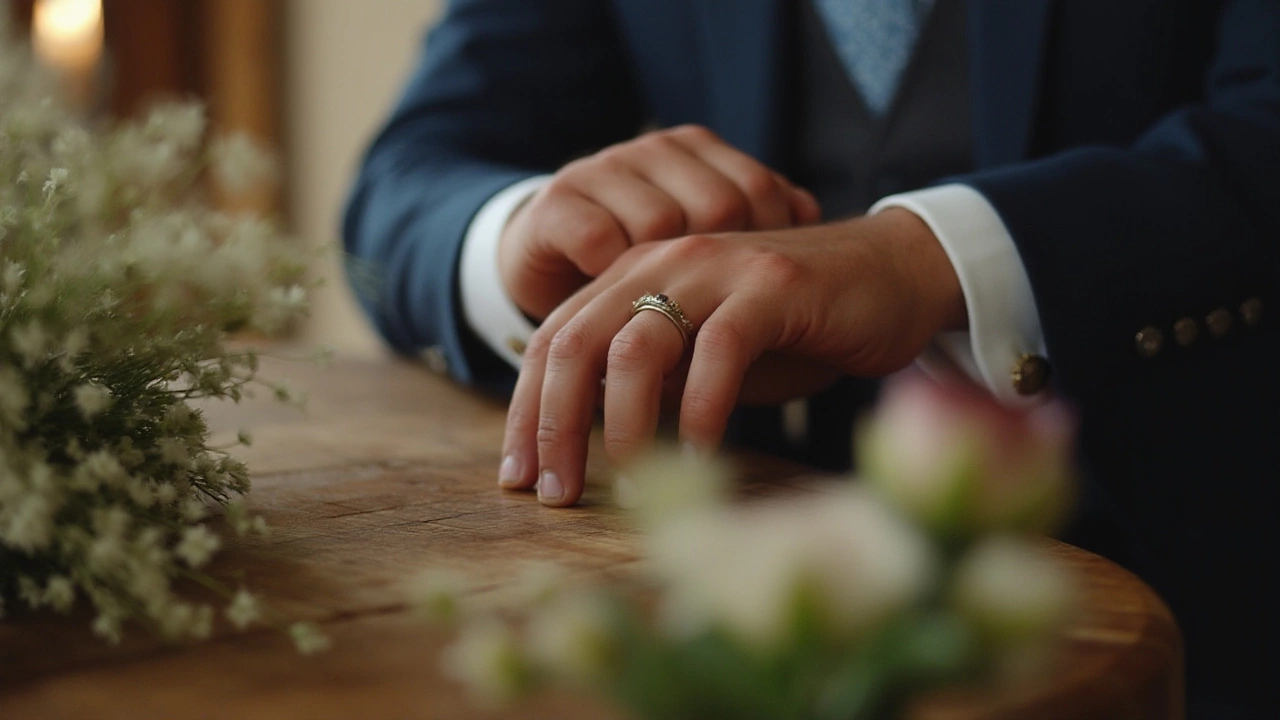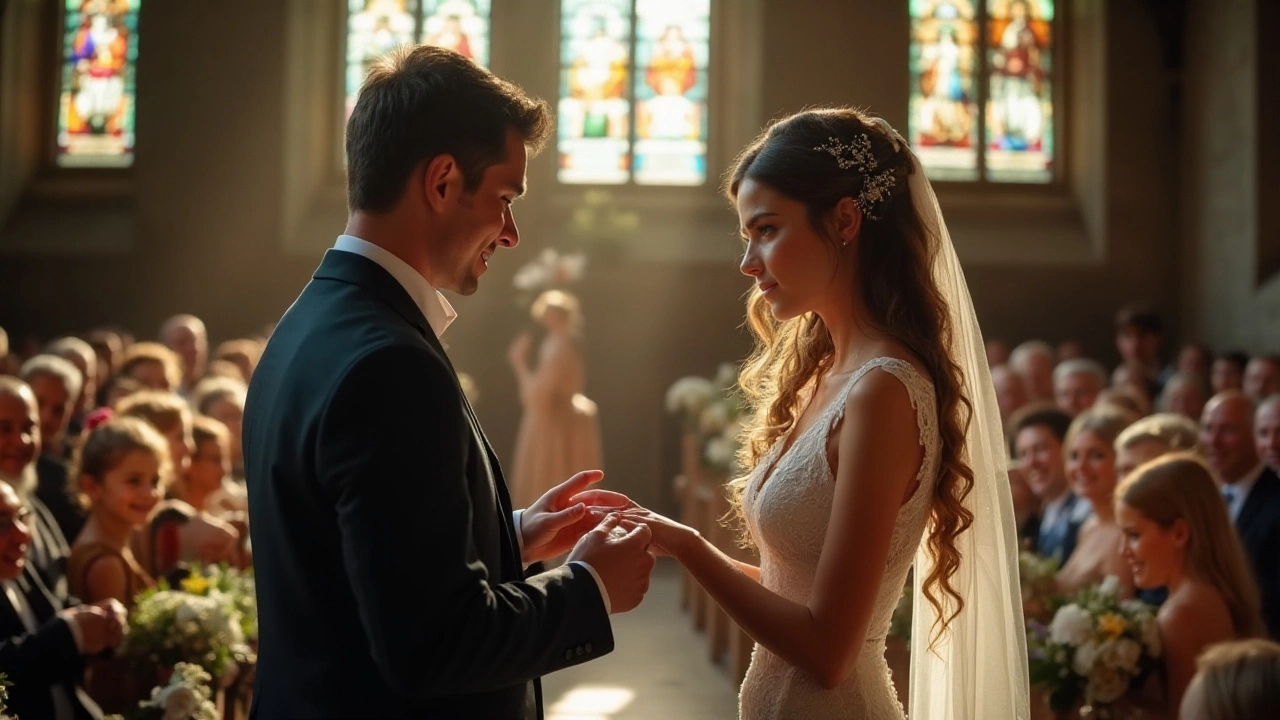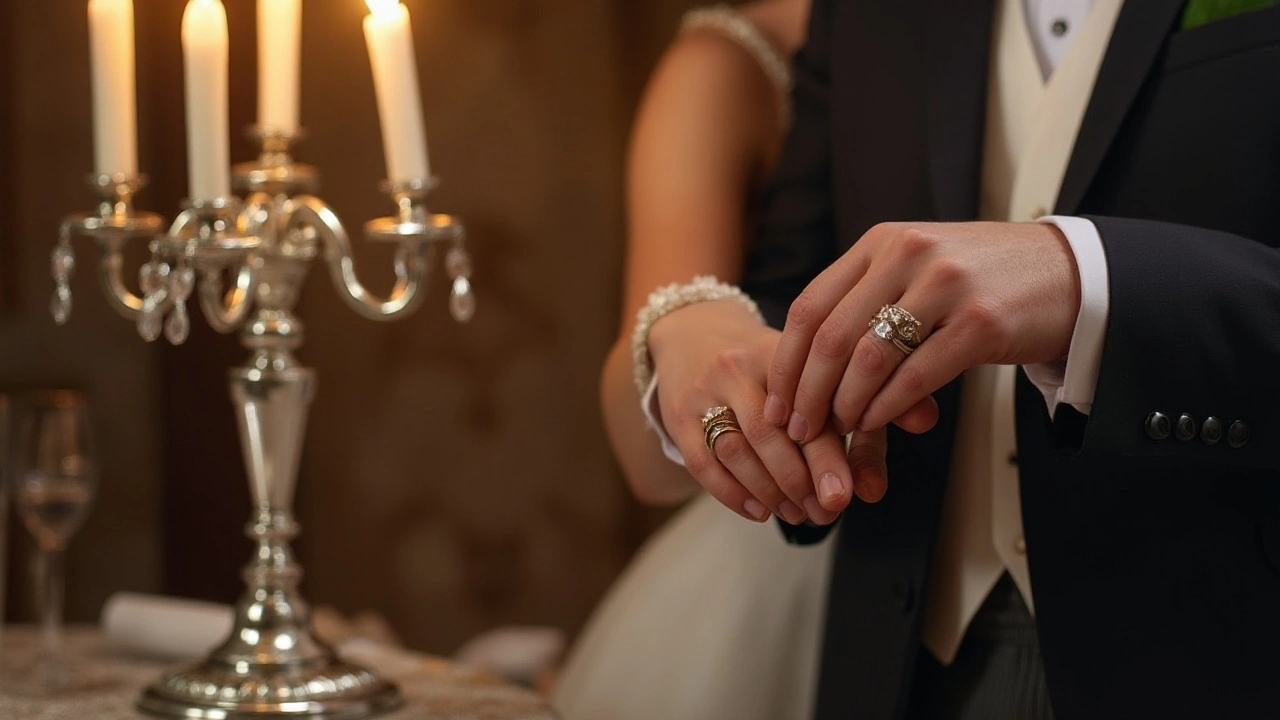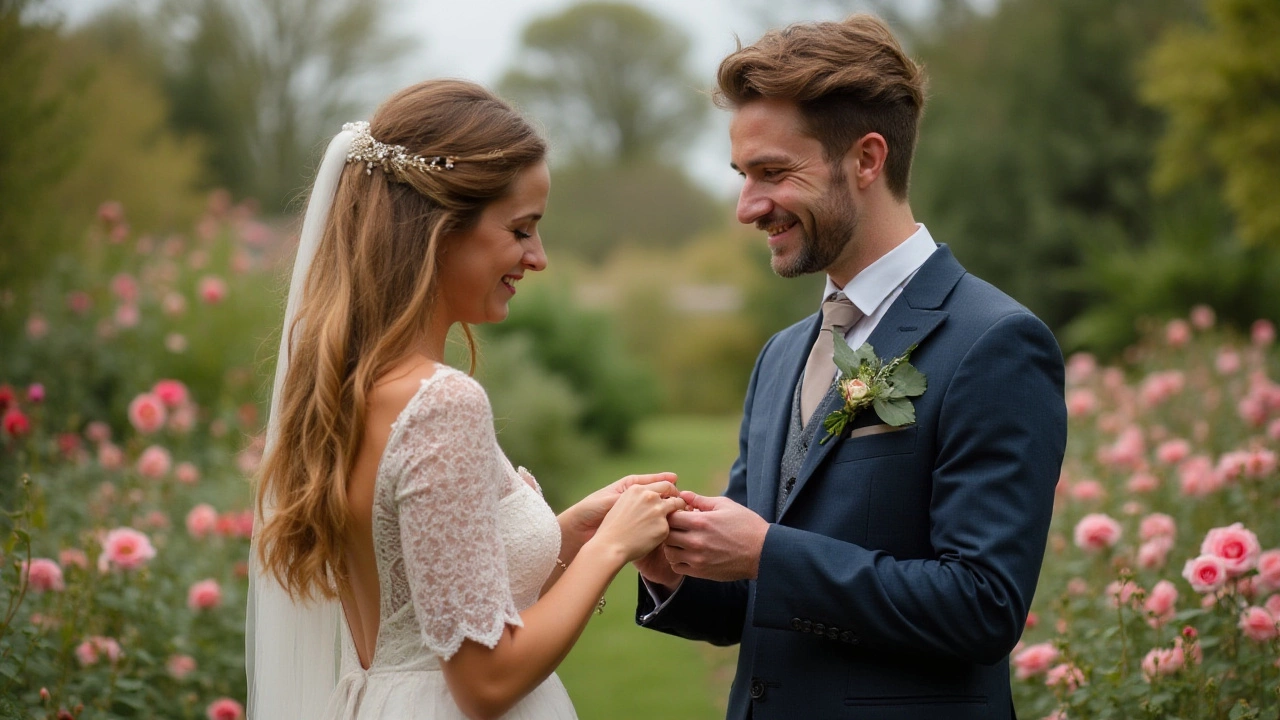Who Places the Wedding Ring on the Groom's Finger?
 Jan, 17 2025
Jan, 17 2025
Weddings are brimming with traditions that weave together personal stories, cultural heritage, and symbolic gestures. One such pivotal moment is the exchange of rings—a ritual stretching back through centuries of commitment and unity.
Traditionally, the spotlight often lands on the bride's hand. However, the moment when the groom receives his ring is just as laden with meaning and significance. Have you ever wondered about who typically places the ring on the groom's finger? Or how this tradition has transformed over time? The story is fascinating, blending ancient customs with modern-day practices.
- Understanding the Tradition
- The Evolution of Groom's Attire
- Selecting the Perfect Groom's Ring
- Tips for Best Fit and Comfort
Understanding the Tradition
Across cultures, the act of placing a wedding ring on the groom's finger signifies an unbroken circle of love and commitment. This tradition dates back thousands of years, with origins rooted in ancient Egypt. The Egyptians regarded the circle as a symbol of eternity, and their belief was that the vein from the fourth finger on the left hand led directly to the heart. This 'vena amoris,' or 'vein of love,' became the natural choice for the placement of wedding rings, cementing the ritual's romantic undertones.
In various cultures, the responsibility of placing the ring on the groom’s finger usually falls to the bride. This exchange is more than a mere tradition; it's a shared promise, an expression of unity and mutual respect. In some ceremonies, both partners hold the ring briefly before it is placed, symbolizing the shared journey ahead and the commitment it represents. Interestingly, in certain traditions, grooms have been known to receive a ring even during the engagement, a practice dating back to the Middle Ages when both partners wore a sign of their impending nuptials.
Modern wedding practices have ushered in new dynamics, making weddings more personalized than ever before. Many couples rewrite the rules, choosing to have those closest to them take part in this moment. A child, a parent, or even both families together may symbolically provide the ring to the groom, broadening the intimate circle of trust and love. This shift honors family and unity, transforming a traditional act into a collective celebration of togetherness.
In the words of Dr. Jane Smith, a renowned wedding historian, "The exchange of rings between partners is steeped in more than tradition; it encapsulates the enduring bond that marriage represents."
The quote by Dr. Smith emphasizes the idea that "Each time we slip a ring on our partner's finger, we engage in a rite that countless have shared, symbolizing a journey both unique to the couple and common among all," she notes.
The enduring appeal of the groom's ring tradition speaks to its dual nature—ritualistic yet personal. It's a moment defined by history yet susceptible to modern interpretations. For some, the ceremony remains intact, mirroring the ancient narratives, while others mold it to fit their unique story, showcasing the flexibility and enduring nature of love. This custom, much like the circle of the ring itself, invites continuous interpretation, ensuring its presence in wedding rituals around the world. Whether adhering to convention or pioneering new traditions, the exchange remains a moment where history meets personal legacy, intertwining to frame a future filled with promise and possibility.

The Evolution of Groom's Attire
When considering the timeless ritual of marriage, the image of a bride's elegant gown often steals the show. Yet, the narrative around groom suits is rich in texture and history, offering a fascinating counterpart to the bridal story. Historically, grooms have donned garments that reflect not only personal style but also the era and cultural context in which they were worn. In the Victorian era, the traditional morning suit was the go-to choice for grooms, characterized by tails, vests, and top hats. As societies evolved, the demands and aesthetics around groom attire have shifted, gradually transforming into what we consider modern elegance today. From the tailored tuxedos of the 20th century to today's embrace of more personalized styles, grooms now have a multitude of options that transcend past conventions.
The advent of the 20th century marked a significant departure from rigid styles. Men began to experiment with color, cut, and fabric, paving the way for the more personalized wedding attire we see today. Particularly after the iconic 1920s Jazz Age, groom attire began dabbling with bolder choices. The classic black tuxedo rose to prominence during this era, and it became a staple for formal weddings. Icons like Cary Grant and Fred Astaire lent glamour and style that inspired a generation. A modern touch is now the blend of vintage and contemporary attire, allowing grooms to express their distinctive tastes. Have you ever wondered how today's grooms choose their outfits? Perhaps, it is this unprecedented freedom of choice that allows them to select pieces reflecting their essence.
Indeed, contemporary weddings no longer insist on rigid conformity to traditional styles; this is where creativity blends with tradition. According to wedding style expert David Tutera, "Today's grooms want to be just as stylish as their brides, capturing tenets of their personalities in their attire."
"Grooms have transcended the monochrome monotony of the past by opting for unique color schemes, individualized accessories like pocket squares, ties, and boutonnieres, which add a splash of character," Tutera says.This current trend, where couples seek coherence and harmony in style, rather than direct matching, extends from suits to carefully selected groom rings, reflecting the stories and identities of both individuals.
Marriage ceremonies have also seen a diversification of themes, impacting how grooms choose their suits. Beach weddings call for lighter fabrics such as linen, while rustic barn weddings may see grooms dressed in tweed or other country-inspired materials. The infusion of culture and heritage is another beautiful aspect seen in ceremonial attire. A groom of Indian descent, for example, might choose a sherwani, while one from Scotland might don a kilt. Statistics show that 70% of modern-day grooms partake in this evolving attire culture. This figure is detailed below in a survey conducted across various bridal studios, representing broader shifts in groom garment choices across regions.
| Year | Percentage of Non-Traditional Attire |
|---|---|
| 1990 | 25% |
| 2000 | 45% |
| 2010 | 60% |
| 2020 | 70% |
As society continues to embrace diversity and personal expression, the sartorial landscape for grooms is, without a doubt, more vibrant and inclusive. The clerk who once advised a three-piece for every occasion is now replaced by stylists and tailors who encourage individuality. There’s no denying that with each wedding season, a new chapter in the story of groom suits continues to unfold, offering a testament to changing times and traditions. This is why indulging in the exploration of attire options is not just a necessity but a celebration of one's unique path down the aisle.

Selecting the Perfect Groom's Ring
When it comes to the choice of a groom's ring, the journey is both an art and personal expression. Think of the groom's ring as more than just a piece of jewelry; it's a statement that reflects the groom's personality, style, and the shared promise with his partner. Before diving into styles and materials, consider what the ring means to you. Each part of the journey, from research to selection, transforms into a story that you will share for the rest of your life. While the bride’s engagement ring might grab attention, a groom's ring whispers of elegance, commitment, and a solemn vow tucked into its band.
The first step in choosing a groom's ring involves deciding on the material. Traditional options include gold, platinum, and titanium, each with its own allure. Gold, with its timeless glow, is symbolic of warmth and fidelity. Platinum offers durability—ideal for grooms who are hands-on with their work, while titanium is famed for being lightweight yet robust, making it a modern favorite. The choice of material affects not only the appearance and feel of the ring but also its longevity. Consider your daily activities and select a metal that not only feels right but is practical for the lifestyle you lead.
Balancing Style and Comfort
Next comes the balancing act of style and comfort. The groom's ring should be stylish yet comfortable enough to wear throughout the day. While many fall for ornate designs, sometimes simplicity holds the charm. Classic bands offer understated elegance and blend well with any wardrobe, while rings with intricate designs can be conversation starters and hold sentimental value. Most jewelers advise fitting sessions to ensure that the size is just right—not too tight to leave a mark and not too loose to slip off. Remember, this ring is not just for a day but a lifetime, so comfort is paramount.
Personalization brings a unique touch to the groom's ring. Inscriptions inside the band could carry a personal message or date that holds special meaning, like the wedding date or a beloved quote. Some couples choose to include their partner's fingerprint or heartbeat inside the band. These small additions transform a simple ring into a cherished heirloom. According to John Doe, a renowned jeweler, "The most exquisite rings are those that capture the essence of the bond between two people, weaving their stories into the very fabric of the metal they choose."
Budget and Practical Considerations
Determining the budget is crucial in the selection process. The cost of a groom's ring can vary significantly based on material, brand, and design. Setting a budget early can help narrow down options and prevent overspending. Consider speaking with several jewelers to compare prices and examine different options. Some prefer custom designs while others may find satisfaction with ready-made ones, each having its unique benefits. Sometimes, more expensive doesn’t equate to better; what matters most is how well the ring resonates with personal preferences and lifestyle.
Finally, remember to maintain the groom's ring after the wedding to keep it looking its best. Regular cleaning, polishing, and inspecting for any damage ensures longevity. Most rings will come with a warranty or a care package from the jeweler to help with maintenance. This simple act of care extends the life of the ring, preserving not just the metal, but the memories entwined within it. Selecting the right ring is more than just a task; it's a journey that celebrates love, partnership, and individuality.

Tips for Best Fit and Comfort
When it comes to selecting a ring for the groom, ensuring the best fit and comfort is an essential task that requires attention to detail. A comfortable and well-fitted ring is not just about aesthetics—it’s about practicality, ensuring the groom can wear it daily without discomfort. First, it's important to understand the finger's natural changes throughout the day. Hands can swell in the summer heat or contract in the colder months. Therefore, measuring ring size in midday is often advisable, when these changes stabilize, providing a more accurate fit. When measuring, a ring should fit snugly enough to prevent it from falling off but also be loose enough to slide over the knuckle without too much strain.
Another crucial element is the choice of metal and design. While rings made from traditional gold remain ever-popular, modern trends see more grooms opting for materials like titanium or palladium, known for their lightweight and hypoallergenic properties. Selecting the right metal ensures that the groom is not only stylish but also comfortable, avoiding potential skin irritations. Furthermore, choosing a band width that complements hand size can be key to comfort. A wider band can feel more secure to some, while others prefer the unobtrusive nature of narrower bands. Testing a few variations and seeing what feels right is a wise approach.
Inside the band, consider different finishing techniques. A polished finish may look stunning but consider how possible scratches might appear over time. A matte or brushed finish can be equally elegant and tends to hide scratches better, providing a more lasting appearance. In terms of design, simple designs are often favored for their timelessness, but providing personalization options such as engravings can add a special touch. Think about adding a meaningful date or initials; these small engravings do not affect comfort but significantly increase emotional value.
Professional Sizing and Considerations
It's recommended to consult with a professional jeweler who can guide both the groom and the bride through the sizing process, allowing them to explore different options and styles while adding expertise to ensure both style and comfort align with the groom's preferences. Jewelry experts can offer advice on sizing while explaining the advantages of different metals and fits. Asking questions during this process can often yield helpful insights. Experts like David Salisbury from The Gem Place advise,
"Never rush the process. Your ring symbolizes love and commitment and should be selected with care and thought."Taking time to understand how each decision affects long-term comfort is crucial.
To wrap up the essentials of choosing a ring that promises both style and enduring comfort, always try on multiple options. Do not feel pressured to select the first ring that catches the eye. Ensure the ring stays the course in terms of comfort over long durations, and remember — the groom’s ring is an item that, in many ways, invisibly aligns with innumerable days and their wide-ranging activities. Making thoughtful, informed choices ensures the groom will cherish wearing his piece of jewelry that symbolizes his union, every single day.